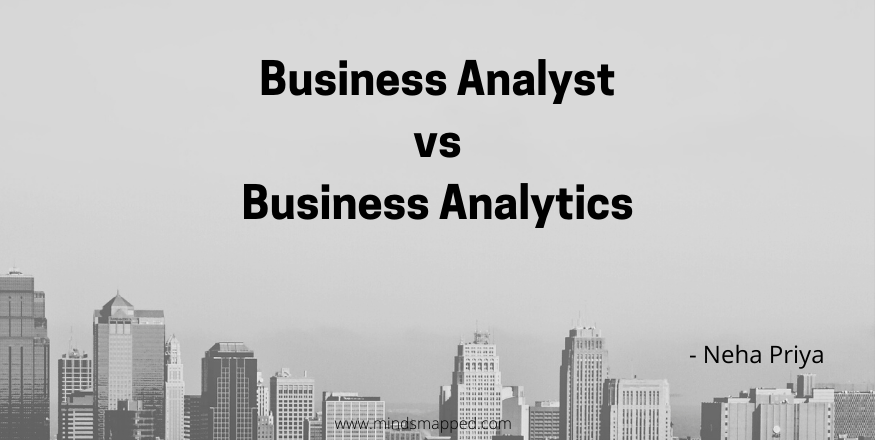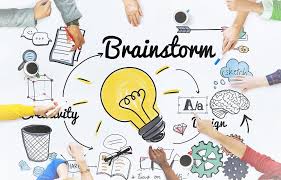
Business Analysis vs Business Analytics
Similarities and Differences between Business Analysts and Business Analytic Professionals
As someone had rightly said, you can’t solve the problem until you are asking the right question.
The above quote applies to both professionals, Business Analyst, and Business Analytics. Their quality of work depends on how much deep diving they have done on understanding the business. The appreciation of their work lies in the intricate detail that they gather throughout the analysis. The terms, Business Analyst and Business Analytics are often interchangeably used, but they differ in the way they work. So, it is inevitable to ask, how many of you play both the roles simultaneously?
Most use cases that these experts are looking for are circumventing around any of the below-mentioned problems:
- Increasing sales
- Optimize internal and external campaigns
- Attracting more customers
- User-friendly and Engaging Application
- Personalized User Experience
- Accessible Application
- Quick checkout
One can briefly decipher from the preceding mentioned bullet points is that at the end of the day, analysts are analyzing the business problems, studying and experimenting with the latest trends, and applying that on an organizational level to achieve success.
Indicator (KPI) metrics for the specific client and delivering resolutions to tackle those. Why KPI discussion is necessary for the analysts? To obtain insights into the following:
- Establish what project success looks like
- Understand how the project fits into the wider business objectives
- To identify the priority outcomes for a project
The KPI workshop is where the analyst’s work with the business to understand what their business objectives are, and how the project we are about to commence fits into those objectives.
The aim is to get a concrete view of what we are trying to achieve at a business level, how this can be mapped to real KPIs and where they currently stand in terms of existing KPIs & metrics & finally where they see the highest priorities. This approach should be used during the discovery phase of the project. We need this information at the very beginning of the project, ideally just after the project kick-off. The output will inform every decision we make moving forward and will ensure that all proceeding research and consultation is focused around the right questions.
Benefits of using this include:
- A common and shared understanding between us and the business of what success looks like
- An agreed business view of priorities
- A view of where the project sits in the wider business strategy & therefore its priority in the business
- When using the DVF (Desirability | Viability | Feasibility) framework, this will form the foundation of the Viability pillar
Business Analysts and Business Analytics – Commonalities
The way, Business Analyst and Business Analytics work might vary, but what are they working towards and the results to be achieved is somewhat similar. Essentially the objective of their work is alike. These professionals are working towards a common goal, and on a high level, it is to improve the business. The enhancement of business gains can be achieved in multiple ways:
- Understand the core business problems
- Understand how to evaluate opportunities
- Effectively do problem-solving to meet real-time customer problems
- Get specifics from the client
- Identify and discuss each touchpoint to get clarity
- Using a prioritization model which drives stakeholders to an agreed consensus on the top 3 priorities rather than focussing on all at a time
- Use Case based on business requirements
- Deliver a presentation of the solution to address the fundamental problem areas associated with business
- Apply Demonstration Excellence to your presentation
- Document the rationale behind the solution
Business Analysts and Business Analytics – Differences
Business Analyst
The different techniques Business Analysts use, to achieve the expected outcome, is what makes them different from Business Analytics. Throughout the Software Development Life Cycle (SDLC), business analysts help in different phases of the project. Due to their specialization with a particular technology or their experience for a long period, they tend to become the subject matter expert from the business end for that particular type of work. Broadly, there are three types of Business Analysts profile. The nature of the work of Business Analysts has outlined the below categorization.
Design Business Analyst works closely in the design phase. They will be working jointly with the service design, user experience, and visual design teams. Their understanding of the design concepts would be much clearer and will assist in achieving business outcomes through their sheer experience and knowledge.
They look after:
- Prototyping and usability testing
- Learning about new trends and best practice
- Interaction design
Functional Business Analyst is a widely used term across the board. Most people reading this article would have heard about this before. In many projects and client sites, this role performs all the business analysts’ work. They tend to have an understanding of a high level of the overall progress of the project. Their role prominence is somewhat in between the responsibilities of Design Business Analysts and Technical Business Analysts.
They are responsible for:
- Requirements gathering
- Information Architecture development
- Frameworks, processes, and methodology
Technical Business Analyst is those who emphasize and focus on the technical restrictions and capabilities of systems to better inform the design, build, and test of our implementation projects. Sitting in the gap between the Business/UX and the developers, Technical Business Analysts play an integral role in translation and governance.
The take care of the following:
- Inform experience design with deep technical understanding
- Provide a deep functional understanding of the technology stack
- Act as the middle-man between UX design and Development delivery teams
- Deliver detailed stories that are used to drive the development of the solution and inform test cases
- Assist with the design/development of API and Microservices
- Develop data models to help organizations understand their digital products
Business Analytics
Business Analytics mostly work with data and statistics. They primarily synthesize data and capture insightful information through it by understanding its patterns. Don’t get sucked into conversations around visits and click-through. They first need to understand what business data they need from the project. The customer might like to find out how many people come to their website and then convert to a sale. Understanding what segments are doing what would help them optimize their marketing spend to the right segments.
If clients do not have any current baseline data, that is alright, but marking this down as a data gap is necessary so that this will be worked upon in the project gradually. Business Analytics specialists sometimes also switch to data scientist job profiles. Business Intelligence and Data warehousing are also important skills for their day to day activities. It all depends on the nature of the project and requirements that shape up the experiences needed for a Business Analytics. As the market is moving towards more personalized online experience, the quest for business Analytics has increased.
Asks appropriate questions to validate data and approach. Build knowledge of different types of analysis, including competitor, market, trend, behavior, cost, and user needs. Collation and interpretation of information captured during the requirements gathering exercise to form a deliverable that can be interpreted by key stakeholders in meaningful ways. Demonstrates the ability to research and synthesize industry trends and leading practices, and the ability to identify relationships between trends and the client’s environment. Gather relevant data for the production of personas and scenarios, identifying potential user segments. Demonstrates problem-solving ability, analyses data, and draws insightful conclusions and begins to develop draft recommendations.
Business Analytics – Responsibilities
As a Business Analytics expert, one can have the following responsibilities to look after:
- Listens actively. Assists in determining client needs by gathering and researching data, conducting fact-finding client peer interviews, and utilizing common tools and analytical methods
- Understand the principles and implementation of traceability approaches
- Coherently summarizes analytical findings. Develops solid conclusions from findings
- Collates data efficiently with some guidance, with strong note-taking skills
- Collects and analyses data to support planning and assessment of strategic change activities
- Contributes to key activities to operationalize a data governance framework
- Understands data warehouse architectures and concepts
- Is competent with conceptual, logical and physical data modeling tools and techniques
- Understands data quality, profiling, standardization, matching, and single views
- Ensures the integrity of data and collection methods.
- Define a mechanism and approach for maintaining traceability of requirements
- Encourages team members in the identification of new opportunities to specialize and drive knowledge sharing.
Earlier, analytics across the web, app, and digital marketing channels had no formal process and were often added as an afterthought or forgotten completely. This meant a potentially rich source of customer data and path to conversion was not available at all or fragmented at best. Hence now it will not be wrong to say, Business analytics forms one of the strongest arms for an organization.
Challenges Business Analytics specialist face:
Every job has their own set of hiccups they face during the process. If the right things are not done at right times, it adds up to the difficulties. I have mentioned few of the challenges that one can encounter while working as Business Analytics:
- No universal concept of what defines a customer
- No single system of record for customer data
- Data quality from some source systems is incomplete or not universally trusted
- Platforms are not being used in an optimal way
- Web-sites built across multiple platforms create far greater complexities in implementation. This lengthens timelines and may create limitations
- Web-site taxonomies that lack clear structuring create additional analytics work and limitations
- Complex customer experiences create issues in reporting
- Personalisation web content that is powered by backend data can be significantly more challenging to architect
- Tech-led initiatives aren’t necessarily seen by the whole of the business.functionality can go live on the web without analytics ever knowing about it or having an extremely limited time-frame to implement, test and deploy
- External agencies involved in marketing can create inter-dependencies
- Building analytics functionality in parallel with web build may create blockers and re-work
Business Analytics – Ways of Working
Since we are trying to understand the differences between Business Analytics and the business analysts, I believe it is important to highlight and worthwhile looking at how a business analytics expert would spend their day:
General Activities
- Creation of business requirement document
- Develop and document processes for known issues
- Up-skill areas of the business responsible for online processes and development to highlight the importance of web analytics and the benefits of involving the analytics teams up-front
- Tag all customer touch-points so a complete picture of how/when you interact with a customer can be seen and the path to conversion can be tracked
- Consolidate data for all customer interactions
Reporting
- Creation of Analytics Reports: Describe how to navigate to a specific report that answers a particular business question
- Explain when to use different types of report
- List the different ways to retrieve data from Reports
- Running reports
Metrics
- Defining metrics
- Differentiate between metric and data dimension reports
- Explain when to use a ranked or trended view of a report
- Generate and configure different types of reports
- List and describe the different types of metrics used in Reporting
- Generate and analyze metric-based reports
- Define what a calculated metric is and how it is created
- Create a calculated metric and apply it to a report
Segmentation
- List the types of segmentation
- Apply segments to reports
- Explain the segmentation logic
- Create segments that answer business questions
Dashboards
- List the key principles behind a great dashboard
- Explain how to add custom report lets to a dashboard
- Demonstrate how to edit, configure, and manage dashboards
Tools used by most of the Business Analytics professional:
- Tableau
- Adobe Analytics
- Adobe Target
- Google Analytics
- Adobe Target
- Adobe audience Manger
- Launch
- Microsoft Excel
- Microsoft PowerPoint
Final Thoughts – Comparison of Business Analysis and Business Analytics Professions
As we saw above in a detailed manner that business analysts and business analytics have varied roles and responsibilities. They are quite different in the way they operate. I have tried enlisting their commonalities and differences as well. The excerpts above is obviously not an exhaustive set of points to ponder upon but a good start to understanding how these two professional differ in what they do.
I hope this article was able to give you a view about who the business analysts and business analytics experts are.



